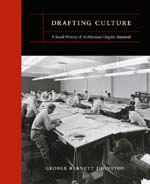
|

|
|
Home Site Search Contact Us Subscribe
|
|
|
Book Review: You've Got to Draw the Line Somewhere: A review of Drafting Culture: a Social History of Architectural Graphic Standards by George Barnett Johnston By Norman Weinstein September 30, 2008 If the magisterial Architectural Graphic Standards by Charles George Ramsey and Harold Reeve Sleeper is really “The Bible” of the profession, it has just as direly needed a “Reader’s Guide” as the King James or Revised Standard translation of holy writ. The sparkling new 11th edition of AGS rivals the weight of many new born mammals and can be just as daunting to tame. Architect and academic George Barnett Johnston has accomplished a rare and valuable penetration into a slice of this architectural bible with Drafting Culture: a Social History of Architectural Graphic Standard (The MIT Press, 2008). And for all of my nagging caveats about his book, I think it is extremely valuable in terms of reading “between the lines” of any and all editions of Architectural Graphic Standards.
Imagine a sane architect promising to read AGS straight through for a year, a feat surely as quixotic in its own way as that of Ammon Shea’s Reading the OED: One Man, One Year, 21,730 Pages. While comprising merely a bit over a thousand pages, AGS is an extraordinarily dense encyclopedia of graphics and numbers that might well require a 21,730-word text to adequately amplify it. Unlike The Bible or the Oxford English Dictionary, the AGS has a clearly functional topical organization, starting with “Building Elements” and moving through “Materials” and “Issues of Contemporary Practice.”
Johnston approached the behemoth by limiting his investigation into a history of the AGS’s first five editions, (e.g. until Ramsey and Sleeper passed away and their original from 1956 on morphed into something else they might have found unimaginable). Johnston digs into the vocation of the draftsman since AGS was originally “the draftsman’s Bible” and essentially writes a thoughtful hymn of praise to draftsmen – that sustaining underclass that kept architects in the business. Central to this study is how architectural practice in America has moved from a foundation staffed by vocationally trained paraprofessionals, the draftsmen, to today’s academically trained professionals.
What makes this point compelling is today’s equivalent of the architectural draftsman is the “CAD jockey” (also increasingly called the ugly moniker of “CAD monkey”). An army of these computer-assisted draftspeople is behind damn near every bit of commercial architecture today. And they draw as much attention and professional respect as their forefathers did working with endless pencils. Think of where any of today’s starchitects would be without their CAD jockeys. So is Johnston suggesting that the more things change in the profession, the more they stay the same?
Sort of. This is from the book’s final paragraph: “Draftsmen didn’t just go away, but their stories went untold. They were reclassified, overlooked, and thus forgotten. The inability or unwillingness of subordinate architectural workers to recognize themselves as such today, their loss of consciousness as draftsmen within the variegated scheme of architectural labor, and the still disproportionate allotment of opportunity within the profession when measured in terms of gender and race are all signs of the profession’s memory lapse.”
Like many good academics, Johnston is prolix to the point of pomposity when what he really means is, “Today’s architectural interns are yesterday’s draftsmen.” And Johnston’s lofty “inability...or unwillingness to recognize themselves” is just airy rhetoric. The AIA has and is struggling to try to banish the term “architectural intern,” and I’ve never met one who hasn’t fully recognized his or her twilight status.
But back to the virtues of this interpretative slice of the first five editions of AGS. Johnston does a fine job making AGS a human story. Howard Reeve Sleeper was an Ivy League WASP turned architect; Sleeper an Irish immigrant turned draftsman. Johnston makes you fantasize how this odd couple thrashed out their contradictory cultural roots and professional sensibilities. The great gift Johnston offers by offering this biographical back story is giving us the capacity to interpret every graphic in AGS as a repository of professional practice anecdotes over the years. Every graphic is a complex tangle of architectural history and folklore and established best practice implicitly.
By relying on consulting any edition of AGS, you’re opening a Pandora’s box, treasure chest, palace of riches symbolically. The cadre of additional contributors since the first five editions have turned AGS from “draftsman’s Bible” into a kind of hyper-Revised New Standard “Architect’s Bible,” the equivalent of a Catholic Bible that would include Gnostic fragments, the Dead Sea Scrolls, and a few irreverent neo-Platonists.
An equally fascinating book could be composed of interviews with architects today about how they use the recent AGS editions in their practice. And another offshoot could be a “how to” reader’s guide for new or returning architects. Best of all, how about an “intern” edition of AGS that costs less than $250 dollars – and comes with a box of drafting pencils?
After all, you’ve got to draw a line somewhere.
Norman Weinstein writes for Architectural Record and other publications, teaches communication skills to architects, and authors the Words that Build series for ArchNewsNow. He can be reached at nweinste@mindspring.com.
|
(click on pictures to enlarge) 
|
© 2008 ArchNewsNow.com